Diastasis recti, a Greek term meaning “separation,” refers to the partial or complete separation of the rectus abdominis muscles along the linea alba; Commonly occurring during pregnancy, it affects postpartum women, causing abdominal wall thinning and potential core instability. Physiotherapy exercises play a crucial role in restoring muscle strength and improving functional stability.
1.1 Definition and Overview
Diastasis recti, or diastasis recti abdominis (DRA), is a condition where the rectus abdominis muscles separate along the linea alba, a fibrous connective tissue running down the abdomen. This separation occurs due to increased intra-abdominal pressure, often during pregnancy, when the growing uterus stretches the abdominal wall. The linea alba widens, causing the two rectus muscles to move apart. While it is a natural adaptation during pregnancy, postpartum, some individuals may experience persistent separation, leading to core instability or functional challenges. Physiotherapy plays a key role in addressing this condition, focusing on strengthening the deep core muscles and improving abdominal wall function to restore stability and strength.
1.2 Causes and Risk Factors
Diastasis recti occurs due to increased intra-abdominal pressure, often during pregnancy, as the growing uterus stretches the abdominal wall. The linea alba, a fibrous band connecting the rectus abdominis muscles, widens under this pressure. Risk factors include multiple pregnancies, carrying multiples, a history of diastasis recti, weak core muscles, and genetic predisposition. Postpartum hormonal changes and lifestyle adjustments can also influence the severity. These factors contribute to the separation of the rectus muscles, potentially leading to core instability and functional challenges. Understanding these causes and risks is essential for developing effective treatment plans tailored to individual needs.
1.3 Symptoms and Diagnosis
Diastasis recti may present with symptoms like low back pain, pelvic girdle pain, or abdominal discomfort. Some individuals experience difficulty lifting heavy objects or notice a bulge along their midline. However, many people with diastasis recti are asymptomatic. Diagnosis involves a physical examination where a healthcare provider assesses the inter-rectus distance (IRD) by palpating the abdominal wall. Self-testing can be done by lying on your back, knees bent, and performing a crunch to feel for a gap between the rectus muscles. Consulting a pelvic health physiotherapist is crucial for an accurate diagnosis and personalized treatment plan, ensuring proper management of symptoms and recovery.

Diastasis Recti Physiotherapy Exercises
Physiotherapy exercises for diastasis recti focus on strengthening core muscles and improving stability. Techniques include pelvic tilts, bridging, and breathing exercises to promote proper engagement and reduce separation.
2.1 Pelvic Floor Exercises
Pelvic floor exercises, also known as Kegel exercises, are essential in diastasis recti rehabilitation. These exercises strengthen the pelvic floor muscles, which are integral to core stability. By targeting the pubococcygeus muscle, they help improve bladder control, reduce pelvic organ prolapse symptoms, and enhance overall pelvic support. Proper engagement involves contracting the muscles as if stopping urine flow, holding for 5-10 seconds, and releasing slowly. Regular practice, combined with deep breathing techniques, can aid in reducing the inter-rectus gap and restoring functional strength to the abdominal wall, making them a cornerstone of physiotherapy programs for diastasis recti.
2.2 Deep Core Strengthening Exercises
Deep core strengthening exercises target the transverse abdominis muscle, which wraps around the spine and pelvis, providing essential support. These exercises are foundational for addressing diastasis recti, as they help stabilize the abdominal wall and reduce the inter-rectus gap. Techniques such as pelvic tilts, bridging, and the bird dog exercise are commonly used to engage the deep core muscles. Proper form is critical to avoid putting unnecessary strain on the abdominal wall. Over time, these exercises improve spinal stability, enhance posture, and restore functional strength, making daily activities easier and reducing the risk of further separation. Consistency and progressive overload are key to achieving lasting results.
2.3 Breathing Techniques for Core Engagement
Breathing techniques are essential for engaging the core muscles effectively, particularly in managing diastasis recti. Diaphragmatic breathing, also known as belly breathing, involves inhaling deeply through the nose, allowing the diaphragm to drop and the abdomen to expand. This type of breathing helps activate the transverse abdominis muscle, the deepest abdominal muscle, which plays a key role in stabilizing the abdominal wall. By practicing diaphragmatic breathing, individuals can improve core engagement, reduce intra-abdominal pressure, and promote healing of the linea alba. Proper breathing techniques should be integrated into all exercises to enhance their effectiveness and support overall core stability.
2.4 Postural Alignment and Body Mechanics
Proper postural alignment and body mechanics are crucial for managing diastasis recti. Maintaining a neutral spine and avoiding slouching can reduce strain on the abdominal wall. Engaging the core muscles gently during daily activities helps distribute pressure evenly. Activities like lifting should be done by bending at the knees and hips, not the waist, to minimize stress on the linea alba. Awareness of posture during sitting, standing, and moving can prevent further separation and support the healing process. Good body mechanics also enhance the effectiveness of physiotherapy exercises, promoting stability and reducing discomfort. This holistic approach aids in restoring functional strength and improving overall core stability.
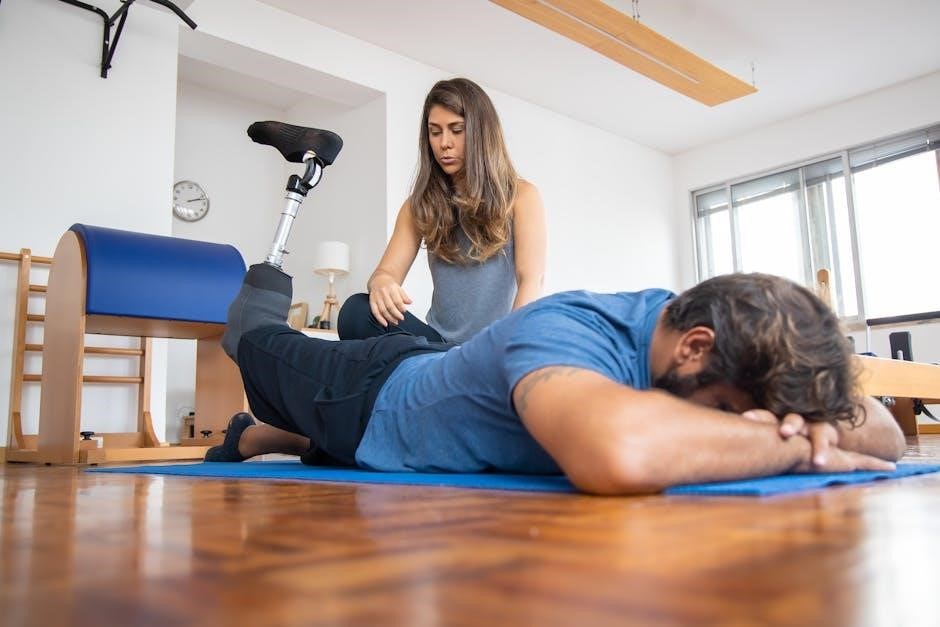
Role of a Pelvic Health Physiotherapist
A pelvic health physiotherapist provides a comprehensive assessment, creating personalized treatment plans to address diastasis recti symptoms. They monitor progress, adjust exercises, and educate on proper movement patterns to restore function and reduce discomfort.
3.1 Assessment and Personalized Treatment Plans
A pelvic health physiotherapist begins with a detailed assessment to evaluate the severity of diastasis recti and its impact on core stability and daily functions. They consider factors like inter-rectus distance, pelvic floor engagement, and overall postural alignment. Based on this evaluation, a tailored treatment plan is developed, focusing on strengthening the transverse abdominis, improving breath patterns, and enhancing pelvic floor coordination. The plan may include specific exercises, activity modifications, and ergonomic adjustments to address individual needs and promote optimal recovery. Regular reassessments ensure the plan evolves with the patient’s progress, fostering a holistic approach to healing and functional restoration.
3.2 Monitoring Progress and Adjusting Exercises
Regular monitoring of progress is essential in diastasis recti physiotherapy to ensure exercises remain effective and safe. A physiotherapist tracks improvements in core strength, pelvic floor engagement, and symptom reduction. They reassess inter-rectus distance and overall functional stability. Based on feedback and progress, exercises are adjusted to challenge the patient appropriately. This iterative process ensures the treatment plan evolves with the patient’s recovery, addressing any plateaus or new challenges. Patient education is also refined to promote proper movement patterns and avoid harmful activities. The goal is to progressively strengthen the core while maintaining optimal alignment and function, tailored to the individual’s needs and goals.
3.4 Education on Proper Movement Patterns
Education on proper movement patterns is a cornerstone of diastasis recti physiotherapy. A physiotherapist teaches patients how to engage their core and pelvic floor muscles during daily activities, such as lifting, bending, and sitting. This prevents further strain on the abdominal wall and promotes healing. Patients learn to avoid movements that cause coning or doming of the abdomen, which can worsen the separation. Proper breathing techniques are also emphasized to enhance core stability. By adopting these mindful movement strategies, individuals can reduce discomfort, improve posture, and safely return to exercise and daily tasks. This empowerment fosters long-term recovery and overall well-being.
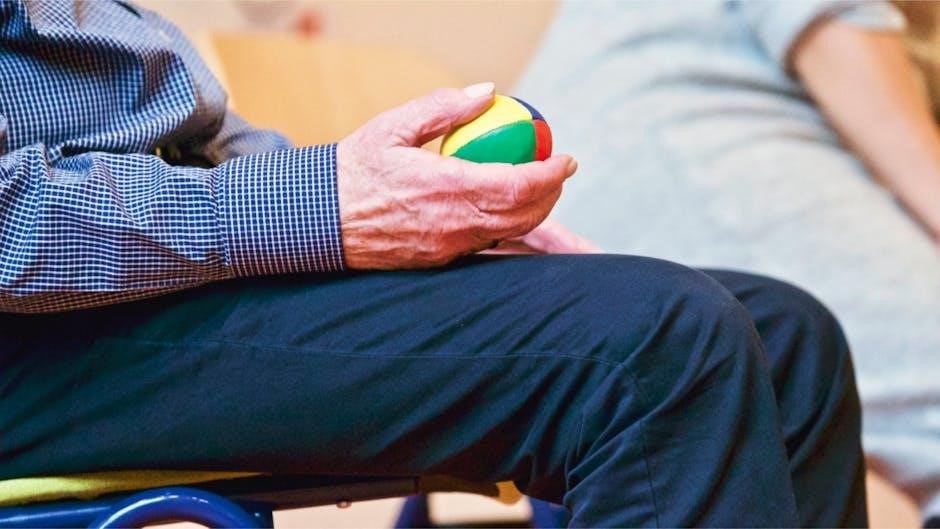
Effective Exercises for Diastasis Recti
Effective exercises for diastasis recti focus on strengthening the transverse abdominis and pelvic floor muscles, promoting core stability and reducing separation. Gentle movements like pelvic tilts and bridging are recommended.
4.1 Pelvic Tilts and Bridging
Pelvic tilts and bridging are foundational exercises for diastasis recti, targeting core stabilization and strengthening the transverse abdominis muscle. Start by lying on your back with knees bent and feet flat. Gently tilt your pelvis upwards, flattening your lower back against the floor, then slowly lift your hips towards the ceiling in a controlled manner. This movement engages the deep core muscles, improving posture and reducing muscle separation. Perform 10-15 repetitions, focusing on slow, deliberate movements to maximize effectiveness and minimize strain on the abdominal wall.
4.2 Bird Dog Exercise
The Bird Dog exercise is an effective core stability movement that targets the deep abdominal muscles and improves spinal alignment. Start on your hands and knees, with your hands shoulder-width apart and knees hip-width apart. Engage your core by drawing your belly button toward your spine. Extend one arm forward and the opposite leg backward, keeping them in line with your torso. Hold for a few seconds, then slowly return to the starting position. Repeat on the other side. This exercise strengthens the obliques, enhances posture, and promotes balance. It is particularly beneficial for diastasis recti as it helps stabilize the spine and reduce muscle separation without overstraining the abdominal wall.
4.3 Plank Modifications
Plank modifications are essential for safely engaging the core without exacerbating diastasis recti. Start with a modified forearm plank on your knees, ensuring your hips are in a neutral position. Engage your transverse abdominis by gently drawing your belly button toward your spine. Avoid letting your hips sag or your abdominal wall bulge. Hold for 5-10 breaths, focusing on stability and proper alignment. Gradually progress to longer durations or more challenging variations, such as lifting one arm or leg, as core strength improves. These modifications help strengthen the entire core while minimizing strain on the linea alba, promoting healing and functional stability.
4.4 Side-Bending Exercises
Side-bending exercises, or lateral flexion, are beneficial for strengthening the oblique muscles and improving posture. For diastasis recti, these exercises should be modified to avoid increasing intra-abdominal pressure. Start by sitting or standing tall, engaging your transverse abdominis muscle by gently pulling your belly button toward your spine. Slowly bend to one side, keeping your arms relaxed or holding light weights. Avoid twisting or arching your back. Hold for a few breaths, then return to the starting position. Repeat on the other side. This exercise helps stabilize the core and improve lateral mobility without straining the abdominal wall. Always prioritize proper form and consult a pelvic health physiotherapist for guidance.
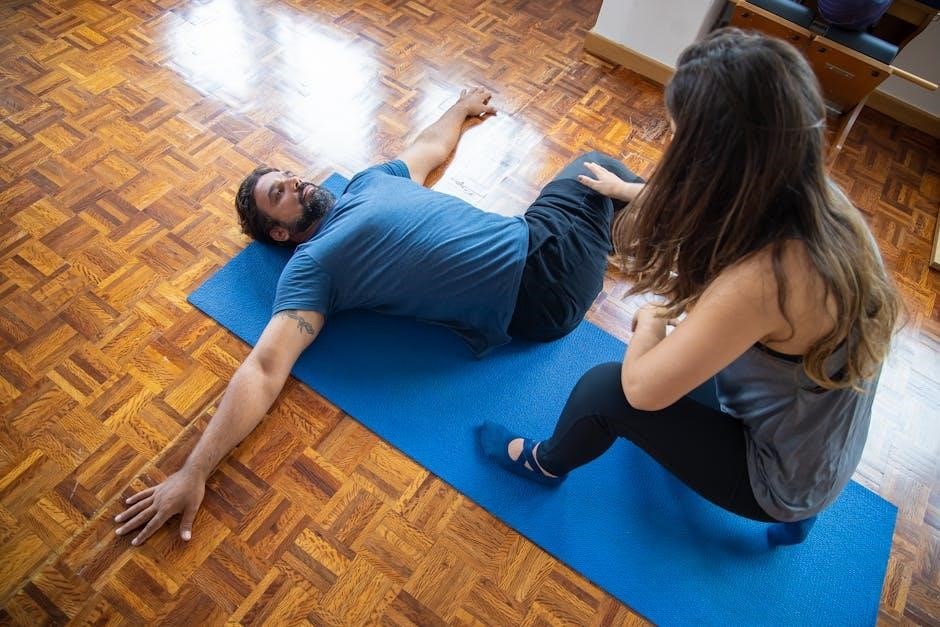
Avoiding Harmful Exercises
Identify exercises that worsen diastasis recti, such as heavy lifting, crunches, and planks, which increase intra-abdominal pressure. Avoid movements causing abdominal bulging.
5.1 Exercises That Can Worsen the Condition
Certain exercises can exacerbate diastasis recti by increasing intra-abdominal pressure, causing further separation of the abdominal muscles. These include traditional crunches, planks, and heavy lifting, which strain the linea alba. Activities that involve repetitive bending or twisting can also worsen the condition. Additionally, any exercise that causes visible bulging or doming along the midline should be avoided, as it indicates excessive pressure on the weakened abdominal wall; Continuing such exercises may lead to prolonged recovery or even require surgical intervention; It is crucial to identify and avoid these movements to prevent progression of the condition and promote healing.
5.2 Safe Alternatives to Traditional Ab Exercises
To avoid worsening diastasis recti, focus on exercises that strengthen the core without increasing intra-abdominal pressure. Pelvic floor exercises, such as Kegels, and deep core strengthening, like transverse abdominis engagement, are safe alternatives. Gentle pelvic tilts and bridging can also help improve abdominal stability without strain. Bird dog exercises, when performed correctly, enhance core coordination and strength. Breathing techniques, such as diaphragmatic breathing, support core engagement and reduce pressure on the linea alba. These exercises promote healing and stability, helping to close the abdominal separation. Always consult a physiotherapist to ensure proper form and avoid movements that cause bulging or discomfort.
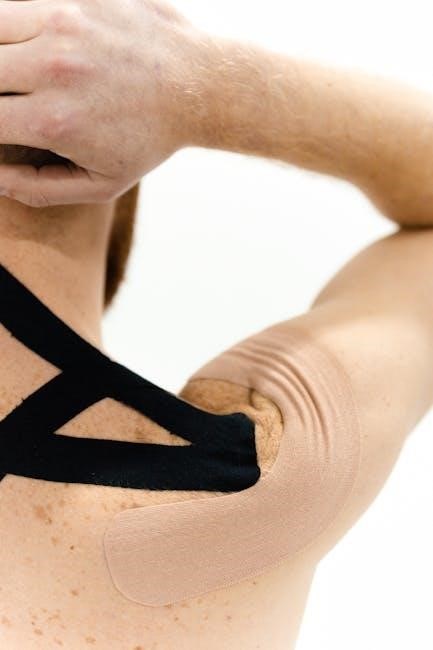
The Importance of Breathing in Exercise
Proper breathing techniques, such as diaphragmatic breathing, enhance core stability, reduce intra-abdominal pressure, and promote effective muscle engagement, aiding in diastasis recti recovery and preventing further strain.
6.1 Diaphragmatic Breathing Techniques
Diaphragmatic breathing is essential for engaging the transverse abdominis muscle, which stabilizes the core and supports diastasis recti recovery. By inhaling deeply through the nose, allowing the belly to rise, and exhaling slowly through the mouth, individuals can activate their deep abdominal muscles. This technique reduces intra-abdominal pressure, preventing further strain on the linea alba. Proper breathing patterns enhance posture, improve core stability, and promote efficient muscle engagement during exercises. Regular practice of diaphragmatic breathing strengthens the inner abdominal girdle, which is crucial for managing and recovering from diastasis recti effectively.
6.2 Engaging the Transverse Abdominis Muscle
Engaging the transverse abdominis muscle (TVA) is crucial for core stability and managing diastasis recti. The TVA acts as an internal girdle, wrapping around the spine and pelvis. To activate it, draw your belly button gently toward your spine without holding your breath. This subtle movement strengthens the deep core and supports the linea alba. Regular practice improves posture, reduces intra-abdominal pressure, and enhances the effectiveness of other exercises. Proper TVA engagement is foundational for safe and effective diastasis recti recovery, as it helps stabilize the abdominal wall and promote healing. Consistent practice ensures long-term core strength and functional mobility.

Lifestyle Modifications for Recovery
Lifestyle modifications are essential for diastasis recti recovery. Focus on activity adjustments, proper posture, balanced nutrition, and hydration to support healing and core strength.
7.1 Activity Modification
Activity modification is crucial for managing diastasis recti. Avoid heavy lifting, bending, or exercises that cause abdominal bulging. Opt for gentle movements and core-strengthening exercises instead. Use proper lifting techniques, engaging your core and maintaining a neutral spine. Consider wearing supportive clothing or abdominal braces to reduce strain. Avoid high-impact activities until core strength improves. Modify exercises like planks or crunches to prevent intra-abdominal pressure increases. Focus on low-impact activities like swimming or walking to promote healing without exacerbating the condition. Consult a physiotherapist to tailor activities to your recovery stage and ensure safe progression.
7.2 Ergonomic Adjustments
Ergonomic adjustments are essential for managing diastasis recti, focusing on reducing strain on the abdominal wall. Ensure proper posture during daily activities, avoiding slouching or excessive bending. Use supportive chairs and maintain a neutral spine while sitting or standing. When lifting objects, bend at the knees and hinge at the hips to minimize abdominal pressure. Avoid carrying heavy bags or objects that strain the core. Optimize workspace setup to reduce reaching or twisting. Consider using a supportive belt or abdominal brace during activities that involve heavy lifting or prolonged standing. These adjustments help minimize intra-abdominal pressure and protect the abdominal wall during recovery.
7.3 Nutrition and Hydration
Nutrition and hydration are vital for healing and managing diastasis recti. A balanced diet rich in protein, fiber, and essential vitamins supports tissue repair and core strength. Include foods high in collagen, such as bone broth, and vitamin C-rich foods like citrus fruits and bell peppers, to promote connective tissue health. Omega-3 fatty acids from fatty fish and flaxseeds reduce inflammation. Proper hydration is essential for maintaining skin and tissue elasticity. Avoid sugary and processed foods that can cause inflammation. Opt for whole, nutrient-dense meals to support overall recovery and abdominal wall integrity. A well-nourished body is better equipped to heal and stabilize the core during diastasis recti recovery.

When to Seek Professional Help
Consult a physiotherapist if experiencing significant abdominal separation, persistent pain, or difficulty engaging core muscles, especially if symptoms worsen with movement or heavy lifting.
8.1 Signs That Indicate the Need for Physiotherapy
Key indicators for seeking physiotherapy include noticeable abdominal separation, persistent pain, or difficulty engaging core muscles. Symptoms such as low back pain, pelvic discomfort, or urinary incontinence may also signal the need for professional guidance. If exercises worsen symptoms or if there’s visible bulging during activities, consulting a physiotherapist is crucial. They can assess muscle separation and overall core function, providing personalized strategies to address these issues effectively.
8.2 How a Physiotherapist Can Help
A physiotherapist specializes in addressing diastasis recti through personalized assessments and tailored treatment plans. They focus on strengthening core muscles, improving posture, and enhancing overall pelvic stability. Physiotherapists teach effective breathing techniques and modified exercises to avoid worsening the condition. They also address related symptoms like low back pain or pelvic floor dysfunction. By providing guidance on safe movements and activities, physiotherapists empower individuals to manage their condition effectively, promoting long-term recovery and functional improvement. Their expertise ensures a holistic approach to healing and restoring core strength.

Recovery and Long-Term Management
Recovery from diastasis recti involves gradual strengthening and lifestyle adjustments. Long-term management focuses on maintaining core stability and preventing recurrence through consistent exercise and proper body mechanics.
9.1 Timeline for Recovery
Recovery from diastasis recti varies depending on severity and individual factors. Mild cases may improve within 6-12 weeks with consistent physiotherapy exercises, while more severe cases can take 6-12 months. Postpartum, natural healing occurs as the linea alba tightens, but full resolution is uncommon. Studies show diastasis prevalence decreases to 50% by 4-6 weeks postpartum and 39% by 6 months. Some women may not return to pre-pregnancy muscle separation but can achieve functional strength. Recovery requires patience, as connective tissue heals slowly. A holistic approach, including physiotherapy and lifestyle changes, supports long-term management and prevents recurrence.
9.2 Maintenance Exercises
Maintenance exercises are crucial for long-term management of diastasis recti. Gentle core-strengthening activities, such as pelvic tilts, bridging, and bird dog exercises, help maintain abdominal muscle engagement. Deep breathing techniques, like diaphragmatic breathing, support core stability. Regular practice of these exercises improves posture, reduces the risk of recurrence, and enhances overall core function. Consistency is key, as maintenance ensures the muscles remain strong and supportive. These exercises should be tailored to individual needs and performed regularly to sustain progress made during recovery. Over time, they help restore functional strength and promote a stable, healthy core.
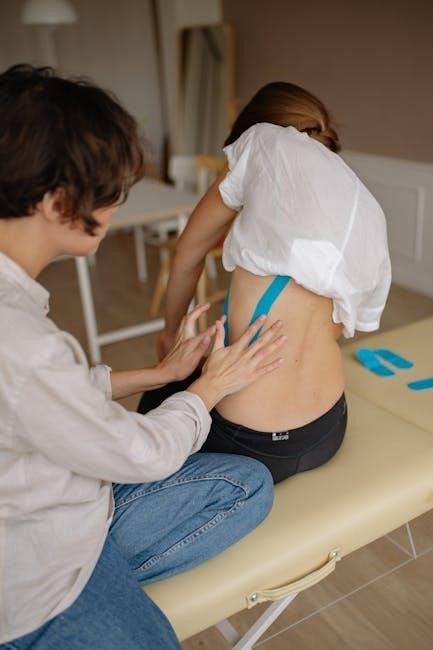
9.3 Preventing Recurrence
Preventing diastasis recti recurrence involves a combination of lifestyle adjustments and targeted exercises. Ongoing core strengthening, proper posture, and mindful movement patterns are essential. Avoiding heavy lifting, bending, or activities that strain the abdominal wall reduces the risk of re-separation. Incorporating exercises like deep core strengthening and breathing techniques helps maintain abdominal muscle integrity. Regular monitoring of physical changes and seeking professional advice if symptoms arise is crucial. A holistic approach, including nutrition and hydration, supports tissue health and healing. By adopting these strategies, individuals can minimize the likelihood of recurrence and maintain long-term core stability and function.
Diastasis recti management involves targeted exercises, lifestyle changes, and professional guidance. For further learning, consult resources like the Tupler Technique or pelvic floor exercise guides. Seek expert recommendations for personalized recovery plans and long-term core strength;
10.1 Summary of Key Points
Diastasis recti, a separation of the rectus abdominis muscles, is common during pregnancy and postpartum. It results from the stretching of the linea alba, affecting core stability. Physiotherapy exercises, such as pelvic tilts and deep core strengthening, are essential for recovery. Breathing techniques and postural alignment also play a crucial role. Avoiding harmful exercises that worsen the condition is vital. A personalized approach, guided by a pelvic health physiotherapist, ensures effective management. Recovery requires patience, as progress may take time. For sustainable results, combine exercises with lifestyle modifications and ergonomic adjustments. Consulting a professional is recommended for a tailored recovery plan.
10.2 Recommended Reading and References
For further understanding, explore resources like Christine Davies’ article on Propel Physiotherapy, detailing diastasis recti physiotherapy. The Tupler Technique guide offers practical exercises for recovery. Peer-reviewed studies in the Journal of Musculoskeletal and Women’s Health provide evidence-based insights. DVDs and online programs, such as those by Julie Tupler, offer structured exercise plans. Additionally, consult with pelvic health physiotherapists for personalized guidance. These resources ensure a comprehensive approach to managing and recovering from diastasis recti effectively.
